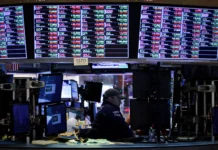India’s central bank has estimated that 99 per cent of the high denomination banknotes cancelled last year were deposited or exchanged for new currency, dashing government hopes that its contentious demonetisation exercise would wipe out huge amounts of “black money”. When Narendra Modi, India’s prime minister, announced in November that Rs1,000 ($16) and Rs500 notes would no longer be legal tender, he suggested that corrupt officials, businessmen and criminals — popularly believed to hoard large amounts of illicit cash — would be stuck with “worthless pieces of paper”. At the time, government officials had suggested that as much as one-third of India’s outstanding currency would be purged from the economy — as the wealthy abandoned or destroyed it, rather than admit to their hoardings — reducing central bank liabilities and creating a government windfall.
But the Reserve Bank of India’s annual report on Wednesday suggested that most holders of the old currency managed to dispose of it, estimating that banned notes worth Rs15.28tn ($239bn) were returned to the bank. That amounts to 99 per cent of the Rs15.44tn of the old high-value notes that were in circulation when Mr Modi made his announcement, according to the finance ministry. The bank’s estimate follows media reports that complex money-laundering networks sprang up in the wake of the demonetisation to help wealthy Indians deposit huge volumes of previously undeclared currency without exposing themselves to tax authorities. Such people allegedly sold the old notes, at a discount, to brokers who then dispatched low-income Indians to deposit or exchange them at banks.
Many wealthy Indians turned to friends and relatives to help them funnel previously undeclared cash into the banking system, while others “advance paid” salaries for large numbers of workers. The government’s critics were quick to seize on the RBI’s announcement as evidence of the policy’s failure. “99 per cent notes legally exchanged! Was demonetisation a scheme designed to convert black money into white?” former finance minister P Chidambaram tweeted. Rahul Gandhi, de facto leader of the opposition Congress party, tweeted: “A colossal failure which cost innocent lives and ruined the economy.
Will the PM own up?” The bank’s figures are a political embarrassment to Mr Modi, who had appealed to the nation to endure the disruption and hardship to punish the rich and corrupt, and deprive them of their ill-gotten gains. Many lower income Indians hard hit hard by cash shortages supported the demonetisation policy because they believed the rich were suffering more.
As they endured long bank queues to exchange old notes for new ones, Indians were also fortified by reports suggesting that some wealthier Indians had burnt, or dumped, their illicit cash to avoid official scrutiny. Arun Jaitley, finance minister, on Thursday defended the demonetisation at a conference in New Delhi. He admitted that black money had come back into the banking system, but said that tax officials were combing through people’s accounts to identify and tax it.
He said: “The fact that money has got into the banking system does not mean that it is all now legitimate . . . The money got identified with the owner whom henceforth had been fixed with the liability of explaining that money and facing taxation on it. “We are now involved in a large amount of data mining and a large number of people are being questioned.” The finance ministry has said it was probing 1.8m bank accounts whose cash inflows during the demonetisation period “did not appear to be in line with its tax profile”, and another 200 “high risk clusters” of people. During the period when the cancelled cash could still be deposited, 148,000 bank accounts received deposits of more than $120,000, with an average deposit size of nearly $500,000.






















